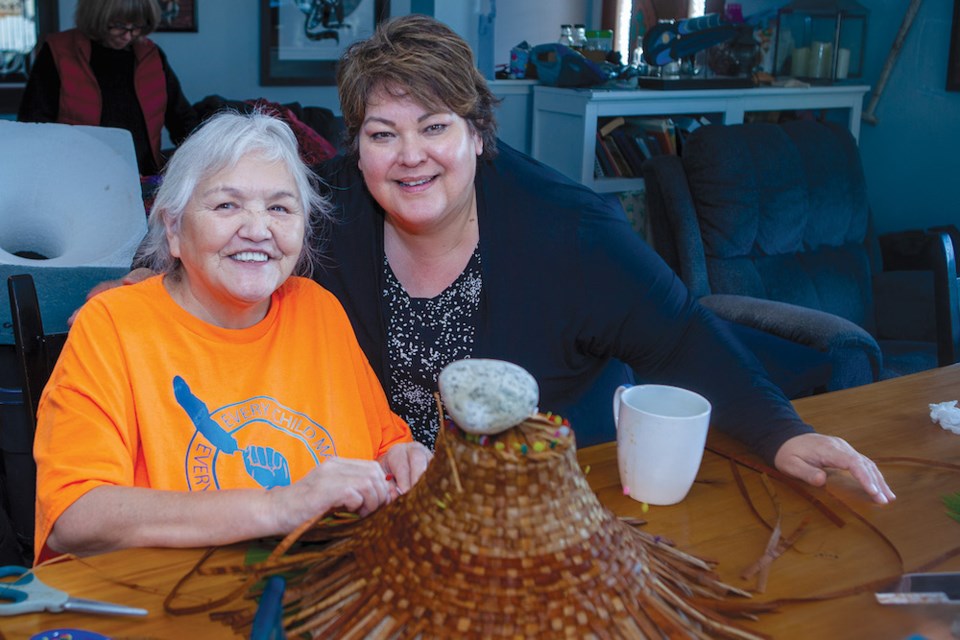Help and support for survivors and their families can be found through the Hope for Wellness Help Line at 1-855-242-3310 or hopeforwellness.ca. A crisis line is also available through Indian Residential School Survivors and Family at 1-866-925-4419.
A cedar weaver from the shíshálh Nation is restoring ceremonial regalia that was confiscated and destroyed in an attempt to sever ties to tradition.
Artist and instructor Shy Watters had originally planned a public hat weaving workshop on Dec. 3. But when she recognized the urgency of a project being led by the Sunshine Coast’s syiyaya Reconciliation Movement, Watters rescheduled the workshop. She gathered instead with three sisters — Fran Paull, Lee Dixon and Brenda Paull — to create cedar hats for survivors of St. Augustine’s Indian Residential School. The school operated in Sechelt from 1904 to 1975.
“In the days of residential schools, regalia was gathered by priests, nuns and [Oblate missionary] brothers,” said Ɂakista xaxanak Garry Feschuk, a former elected chief of the shíshálh Nation and a co-founder of the syiyaya Movement. “They put the regalia into a field and burned it right in front of our whole community.”
Typically, ceremonial regalia consisting of woven hats, headbands, shawls and capes would be passed from one generation to the next. The items are adorned with hereditary symbology of Coast Salish culture. Destruction of the items ruptured links to ancestors and identity.
A year ago, members of the syiyaya committee collected names of residential school survivors affected by the loss of regalia, and family members who will stand in for now-deceased family members touched by the same trauma.
“We’re working with Shy and other artists in our community,” added Feschuk. “When the regalia is done, we’re hoping to have a ceremony where we’ll dress them all in their [restored] regalia. We’ll bring them to the longhouse for a ceremony. We’ll give back their identity that was stolen when they went to residential school.”
The list of candidates for new regalia now exceeds 180 members of the shíshálh Nation.
For Watters, recreating woven cedar regalia is another step on a creative journey that began two decades ago. Knowledge keeper Fran Nahanee led a small group into the rainforest of the Sechelt Peninsula to demonstrate harvesting red cedar. Afterward, Watters received the remainder of her instruction over the telephone as she juggled professional responsibilities at the local school district.
“Fran loaned me a hat mold, and from that point on I pretty much learned on my own about the different hats and designs,” recalled Watters. “And now, 22 years later, I’m pretty much known worldwide.”
In May, Watters was invited to submit one of her woven cedar graduation caps to the American History of Natural History in New York City. The hat will appear in a new gallery showcasing art from the northwest coast. She has recently shipped hats to clients in England and Germany. During the height of COVID restrictions, she began leading weaving workshops through online video, blending an ancient practice with cutting-edge technology.
Watters continues to harvest her own cedar. Her three sons also began a tradition of presenting her with cedar bundles on Mother’s Day. “Just a few years ago I started asking for chocolate,” Watters laughed. “Yeah, I’ll take a whole whack of bundles, but don’t forget about the box of chocolates, guys.” Her three-year-old granddaughter has also learned to pull and split cedar.
As each hat is woven, a stone is placed atop the crown. “The weight of the stone keeps the hat down,” Watters said, “but for me, it also brings our grandfathers into the circle of weaving.”
According to Feschuk, regalia restoration and syiyaya’s recent Reconciliation Sidewalk Project are a steadying force for Indigenous people rocked by successive waves of grief. “We know there will be a report coming out soon from the ground penetrating radar [survey of burial sites related to the residential school],” Freschuk said. “We want to lift up people’s spirits, because we don’t want our survivors to go back into survival mode.”

.png;w=120;h=80;mode=crop)


